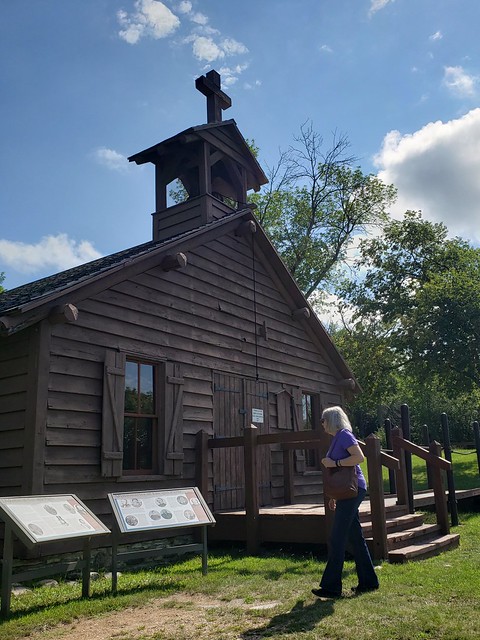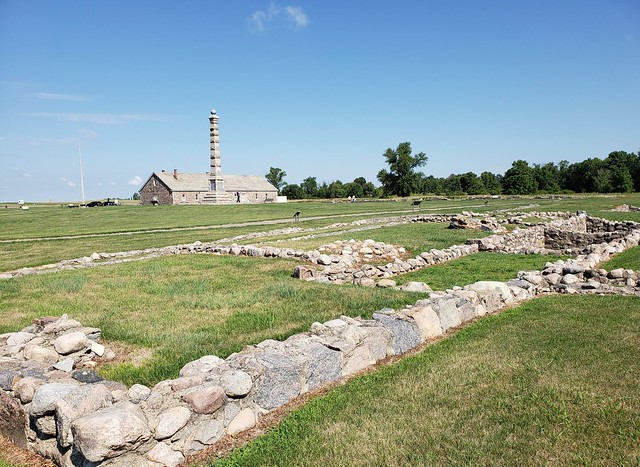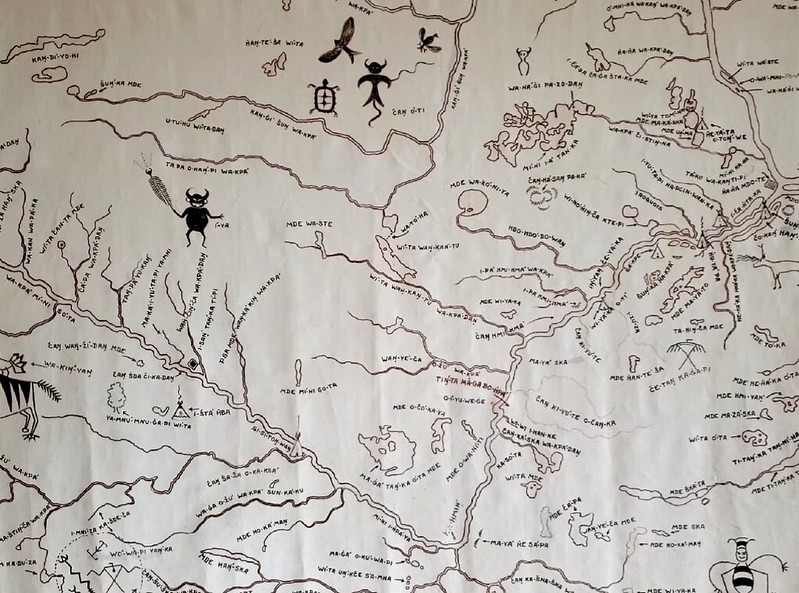I have been so preoccupied with planning a run for Congress and learning French that I have just gone through one of my longest draughts in book reading. Fighting the Red Plan between 2008 and 2010 was the other book draught. From 1979 to the present reading 5 to 8 history books a year was my routine. So, I’m back to reading books and I have a considerable backlog. Travels with George was the first to successfully humanize Washington. Posterity froze him in place with his impossible dentures and Author Nat. Philbrick finishing the last of a series on our first president talked about George’s travels across the new nation by land mostly that he had been elected President to. I had the sense he was addressing issues raised by another Author who I’d read a few years back.
I began reading a second book before Claudia and traveled the harrowing trail of native Americans down the Minnesota River Valley to the sights of the “Sioux Uprising.” I read as we traveled. Its “38 Nooses.” Washington’s admirable successor Lincoln is a big part of why I’ve had my eye out for the book since reading a review of it ten years ago. I bought it at our public library’s fundraising sale a couple weeks ago.
Traveling the river valley was Claudia’s idea. She’s spent a month reading about the sioux uprising for a Christian book group. She was particularly interested in a woman Sarah Wakefield who was captured by the Dakota and subsequently wrote a sympathetic book about her six weeks as a hostage in a teepee. She was devestated when her friend Chaska who protected her was executed in a mass hanging in Mankato, Minnesota. I was startled as a 12 year old to see a celebratory commemoration of the mass hanging of 38 Indians on the now long demolished Main street Bridge when I moved into North Mankato in 1963.
The rest of the books title is: Lincoln Little Crow, and the beginning of the Frontier’s end. By the time America woke up from the 1950’s the stone got red paint thrown against it and it stopped being a tourist plus for Mankato. By my college years a city official had the sign buried. It was the subject of my fourth Not Eudora column before I chose “Not Eudora” as my column’s title. (today I’ll start a column after my recent hiatus to challenge Pete Stauber for Congress and I’ve chosen a new title for my columns)
Lincoln is criticized for an incomplete act of clemency today. He took a list of 300 men to be hanged and whittled it down based on the sketchy evidence submitted with their names to 38 doomed men. Today we know that several of them were wrongfully executed. In fact, as the book makes out all of the Dakota would pay a heavy price for their rebellion guilty or innocent pro rebellion or against it. After being cheated out of their land in previous treaties and denied compensation leading to starvation diets younger warriors, who didn’t understand the vast resources arrayed against them, started a war. It lasted six weeks. For Lincoln it was a distraction and it coincided with and complicated the Presidents’s plan to release the Emancipation Proclamation freeing slaves in rebelling southern states. All of this is covered in the eight chapters I’ve read to date and I’m impressed with the author’s 360 degree view of the world from the Minnesota River Valley and beyond to Washington D.C.
We began our trip by driving to Lakes Traverse and Bigstone which form a westward projecting bump into South Dakota. Between these two twenty mile long lakes lies a marsh for migratory waterfowl on top of a continental divide. The waters of Traverse flow North through through the Red River into Canada and thence into Hudson Bay and the Arctic/Atlantic Ocean. The waters of Bigstone flow out through the Mississippi River to the Gulf of Mexico. The puny Minnesota River which flows to the Mississippi runs the course of a two mile-wide trench carved deep into the plains of southern Minnesota by melting of North America’s mile high glaciers. The valley is littered with huge stones pushed by the glaciers over the valley’s flood plain. Heavy snow melts and rain can flood the valley. Mankato was flooded the year I was born and again when I was in junior high. In a 1965 flood our school was recessed and all the boys were drafted to sandbag the river banks as the water rose. We helped save the day. The levees keep rising to stay ahead of future floods.
I mean to start writing again after I get my campaign clean up duties sorted. We drove through the Mankato University campus as parents were dropping their freshmen students off to start their college years. UMD will follow suit a week later. I’m tempted to marshal some UMD students to help defeat Pete Stauber.
I’ve sent pictures of my three day journey to my French pen pal and gave her a geologic and a history lesson while doing so. BTW for the past forty years Dakota riders have traversed the trail annually on horseback to the site of Mankato’s mass hanging. They end at what is now called reconciliation park.
The drive to Ortonville from Duluth on the southern shore of Big Lake was a little over five hours. The map below was in the New Ulm County Museum and shows the length of the Minnesota River and the individual campgrounds where the Dakota Indians had been required to move preventing them from reaching game while government food was denied them although it sat uneaten in local warehouses. Hundreds would die before the insurrection was put down by Minnesota’s Indian trader Henry Sibley later to become the state’s first governor. Having taken a Dakota as a wife he was considered family and knew the ways of the Dakota. By showing little mercy he was rewarded with higher office.

In Ortonville we encountered turkeys running across the streets.

But the marshes to Biglake’s outh where the Minnesota began were the real aviary and part of the flyway for migrating fowl. You can see in this photo where the lake gets its name.

At the first major tributary since damned up there was a Christian mission. Presbyterians got into the business and helped create a written language for the translation of the Bible into Lakota. A passage in the Bible led many Christians in the 1800’s to become linguists to turn oral only languages into written languages. The biblical passage suggested that God would not bring about Earthly salvation until every person on Earth had access to God’s word. Today such Bibles are an important tool for a great many peoples trying to save their languages recover them.

Below is one of many outdoor signs explaining the world of the Dakota and in this case it shows the not long gone prairie grasslands of central north America. Behind the sign is a small patch of prairie which is being coaxed back into existence in parts of Minnesota.

At the Upper Sioux Agency a trader who told hungry Dakota to eat grass was later killed and his mouth was stuffed with grass. We stopped at the reservation’s casino and I had a flaky cod dinner.

Most of our travels were near the river on this scenic highway in a landscape so green it hurt your eyes:


For our second night we stayed in Redwood City after we left the next day we visited the long abandoned site of Ft. Ridgley where an attack by the Dakota was repulsed.

I sent a picture of a gopher to my French pen pall without mentioning that it was Minnesota’s mascot.

On our way to New Ulm we stopped at this haunting little memorial to the 40 German settlers killed in the small town of Milford. New Ulm named for Ulm Germany offered a museum which explained the German’s difficult acceptance in America.

In New Ulm we stopped at the county museum and learned how the Germans of America helped finance a tribute to Germans to feel better about themselves after their treatment. Ironically after the First World War more resentment against Germans left the memorial neglected. Today is been spruced up and is called Herman on the Hill or Herman the German. Herman was a German who defeated the Romans about the time of the birth of Christ and kept the Romans from invading the scary forests of such fierce warriors.

One of my surprises was the small section dedicated to children’s author Wanda Gag who penned, in both senses of the word, the book Millions of Cats. I heard it read dozens of times on Captain Kangaroo. Her father was a significant illustrator of historical paintings. Here you get the sense of an adventurous young woman of the Roaring Twenties.

As I mentioned Mankato is visited annually by Dakota’s retracing the Minnesota River ending at a Reconciliation Park. My friend who I sent three card decks too had a friend who farms land taken for the Dakota who one year walked along side the horses at a means of seeking atonement for his good fortune at the Indian’s expense. At his death four Dakota came to his service in thanks for a friend in spirit.

A block from my old house stands this memorial to the war that had most of Lincoln’s attention when the Dakota distracted him as he planned his announcement of the Emancipation Proclamation. Where this statue lies was a 300 year old elm which had been the center of the park until a few years after our nation’s bicentennial celebrations. My mother’s illustrated the tree and it became Mankato’s symbol of the bicentennial. It succombed to Elm Disease a few years later leaving a lonely stone memorial (seen in the rear of the fountain) to the GAR….the Grand Army of the Republic……the 18th century’s Veterans of Foreign Wars for Civil War veterans of the North.

Coincidentally our wedding anniversary falls on the anniversary of the start of the “Sioux Uprising.” We walked to the now closed Congregational church where we were married before having a lovey anniversary meal at the hotel we stayed at. Learning that it was our 48th anniversary the manager upgraded us to the ninth floor penthouse of the Hilton Garden Inn. We began our walk with a tour of the sculptures on a long art walk and after desert we walked to the Reconciliation Park at the site of the hanging. Before retiring for the night I read a chapter of the history 38 Nooses.
Twelve miles north of Mankato on the way home we stopped at the Traverse de Sioux Treaty site where the Dakota’s lands began being swallowed up. I’ve passed the Nicollet County museum, dozens of times without ever visiting it. This time we made a stop. Being a map lover I snapped this map of the place names in the Dakota language of the entire Minnesota River region.

